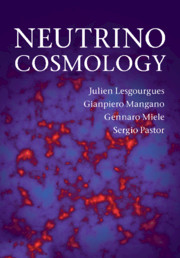Book contents
- Frontmatter
- Contents
- Preface
- 1 The basics of neutrino physics
- 2 Overview of the Standard Cosmological Model
- 3 Neutrinos in the early ages
- 4 Neutrinos in the MeV age
- 5 Neutrinos in the cosmic microwave background epoch
- 6 Recent times: neutrinos and structure formation
- 7 Cosmological neutrinos today
- References
- Index
1 - The basics of neutrino physics
Published online by Cambridge University Press: 05 March 2013
- Frontmatter
- Contents
- Preface
- 1 The basics of neutrino physics
- 2 Overview of the Standard Cosmological Model
- 3 Neutrinos in the early ages
- 4 Neutrinos in the MeV age
- 5 Neutrinos in the cosmic microwave background epoch
- 6 Recent times: neutrinos and structure formation
- 7 Cosmological neutrinos today
- References
- Index
Summary
Like the actors in ancient Greek tragedy and comedy, neutrinos play more than one role in the drama of the expanding universe. They couple to gravity and contribute to Einstein equations which rule the expansion dynamics. Furthermore, they interact in the primordial plasma with charged leptons and hadrons via electroweak interactions, until the rates for these processes become so low compared with the typical expansion rate that they decouple and start to propagate freely along geodesic lines. Any quantitative description of their role in cosmology thus requires several inputs from the theory of fundamental interactions, as well as a knowledge of their basic properties, such as masses and, in some cases, the features of neutrino flavour oscillations.
Neutrino interactions have been well understood since the first theory of β- decay proposed by Enrico Fermi in 1934, and now are succesfully and beautifully described by the unified picture of electroweak interactions. In the low energy limit the strength of these interactions is encoded in a single coupling, the Fermi coupling constant GF, whose value, combined with the Newton constant, fixes the time of neutrino decoupling. From the strong experimental evidence in favour of neutrino oscillation, we also know that neutrinos are massive particles, and this, as we will see at length in the following, has a strong impact on how structures, i.e., inhomogeneities in the universe, grow on certain length scales.
- Type
- Chapter
- Information
- Neutrino Cosmology , pp. 1 - 52Publisher: Cambridge University PressPrint publication year: 2013



